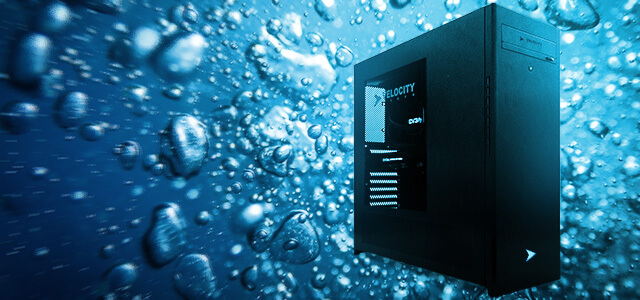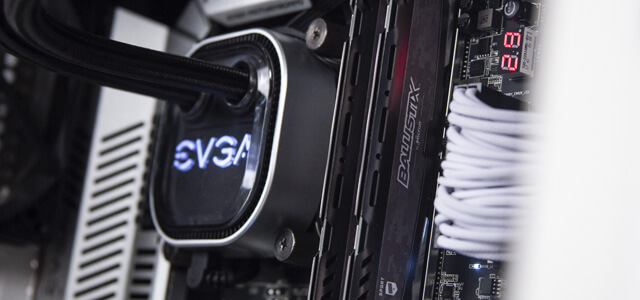Liquid Cooling a PC
Liquid Cooling is the best mainstream way to cool a high-end overclocked desktop CPUs and GPUs. A large high-quality liquid cooling system will typically be able to handle all the cooling needs of even the most power-hungry systems.
In this article we will discuss the different types of liquid cooling systems, so that you can figure out which is right for you.
Types of Liquid Cooling Systems
There are a few different types of liquid cooling systems that you can buy. Each has advantages and disadvantages. Below we will take a look at a few of the most popular ways to liquid cool your CPU or entire system.
All in One (AIO) Liquid Cooling
AIO’s or All in One liquid cooling systems are the simplest way to get quality cooling into your PC. These systems typically consist of a sealed radiator, pump, and block. The advantage of these systems is their ease of use and self-contained fluid. You don’t have to worry about filling or draining these systems. An AIO is about as simple to install or remove as any standard fan.
AIO cooling systems are also generally more affordable then custom cooling. While they are primarily designed for CPU’s, there are many brackets that allow you to use them with some GPU’s as well.
Disadvantages of AIO Cooling Systems
- Performance: AIO’s can not match the high-end performance of larger and more flexible custom systems
- Looks/Style: All in one coolers tend to have standard designs with limited customization and fixed tubing. While they certainly don’t look bad, they don’t offer the level of customization that custom cooling can.
- Versatility: These systems are typically designed to work with CPU’s and are not expandable. That means you will most likely need two if you want to cool your CPU and compatible GPU.
Most Common AIO Radiator Sizes
AIO’s also come in a variety of sizes. The stated size of an AIO tells you how large the radiator and fan(s) will be. AIO sizes typically come in multiples of 120mm but some are also 140mm.
- 92mm: Not a common size, used primarily for compact ITX systems
- 120mm: Most common and affordable AIO, used for primarily for mid-range components
- 140mm: Offers slightly more surface area then
- 240mm (2×120): Increasing in popularity, used for overclocked components
- 360mm (3×120): Expensive, used for high end multi-core overclocked components
AIO’s typically range in thickness from 27-45mm. The thicker and longer your rad, the more potential cooling capacity it will have.
Custom Liquid Cooling
Custom Liquid Cooling typically features the similar radiator sizes to common AIO’s. In addition to all the sized listed above for AIP’s, you will also find extremely compact and oversized radiators when you jump into the custom market.
A custom loop can offer truly crazy levels of cooling. Unlike AIO’s you can design a custom cooling system that integrations your CPU, GPU, and even RAM or board components.
You can also combine multiple radiators in different positions into one single massive liquid cooling system.
Additional Custom Radiator Sizes
- 60mm
- 80mm
- 160mm (2×80)
- 184mm (2×92)
- 200mm
- 360mm (2×180)
- 400mm (2×200)
- 420mm (3×140)
- 480mm (4×120)
- 560mm (4×140)
- 840mm (6×120)
So, as you see there are a ton of options if you want to go with a custom loop. You can go as large or as small as you want/need.
In addition to a radiator you will also need the following:
- Reservoir: A tank for holding your cooling fluid
- Pump: The physical pump that pushes liquid through your system
- CPU/GPU Block: A block sits on top of your components and pulls heat into the
- Tubing/Pipe: The Tubing or Piping depending on what material you select connects your radiator, pump, reservoir, and block(s)
- Fittings: Fittings connect your tubes or pipes to the other components in your liquid cooling system.
- Coolant: The coolant used to conduct heat in your system.
- Fans: Fans push or pull air through or from your radiator and remove the heat from your liquid cooling system.
If this sounds complicated, that’s because it is. There are almost too many options to count. I would not recommend jumping into building a custom cooling system without first doing a ton of research.
Advantages of Custom Liquid Cooling
- Performance: Custom Liquid Cooling can off unrivaled CPU & GPU cooling performance
- Compatibility: Unlike AIO’s custom cooling can accommodate as many graphics cards and processors as you would like.
- Looks: A custom system can be built to look however you would like. You are only limited by your imagination.
Disadvantages of Custom Liquid Cooling
- Pricing: Custom Loops can be wildly expensive depending on what components you select. Fittings alone can cost more than some complete AIO’s
- Risk: Custom loops can be more prone to failure then AIO’s or air coolers. They have more points of failure then other methods of cooling.
- Compatibility: This type of cooling system is usually built to fit in one case, or with a specific set of components and layout. Upgrading a single component like your motherboard or GPU may mean you have to start from scratch.
There are many advantages and disadvantages to both liquid cooling options. Which option is best for you will largely depend on your budget and cooling needs.
Charlie O'Donnell
Latest posts by Charlie O'Donnell (see all)
- How to Clean Dust From Your PC - June 14, 2022
- How to troubleshoot your broken PSU - June 7, 2022
- What is a Workstation Computer? - June 17, 2021

